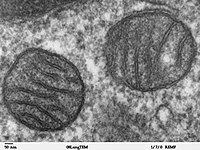
Photo from wikipedia
Simple Summary Mitochondria, which play crucial roles in energy production and in maintaining cellular homeostasis, are potential therapeutic targets in a variety of diseases including cancer. This review discusses methods… Click to show full abstract
Simple Summary Mitochondria, which play crucial roles in energy production and in maintaining cellular homeostasis, are potential therapeutic targets in a variety of diseases including cancer. This review discusses methods to evaluate the structural and functional parameters of mitochondrial health in the context of tumors and cancer cells. These methods include microscopy to examine mitochondrial morphology, PCR to measure changes in mitochondrial DNA content, and various technologies, such as Seahorse analyzers and the Clark electrode, to measure metabolic function. Other functional parameters, such as membrane potential and oxidative stress levels, can be measured using commercially available dyes and assays. By leveraging these techniques, insights can be gained into the biology, metastatic potential, and response to therapy of tumors, ultimately leading to improved treatment plans. Abstract Mitochondria are regulators of key cellular processes, including energy production and redox homeostasis. Mitochondrial dysfunction is associated with various human diseases, including cancer. Importantly, both structural and functional changes can alter mitochondrial function. Morphologic and quantifiable changes in mitochondria can affect their function and contribute to disease. Structural mitochondrial changes include alterations in cristae morphology, mitochondrial DNA integrity and quantity, and dynamics, such as fission and fusion. Functional parameters related to mitochondrial biology include the production of reactive oxygen species, bioenergetic capacity, calcium retention, and membrane potential. Although these parameters can occur independently of one another, changes in mitochondrial structure and function are often interrelated. Thus, evaluating changes in both mitochondrial structure and function is crucial to understanding the molecular events involved in disease onset and progression. This review focuses on the relationship between alterations in mitochondrial structure and function and cancer, with a particular emphasis on gynecologic malignancies. Selecting methods with tractable parameters may be critical to identifying and targeting mitochondria-related therapeutic options. Methods to measure changes in mitochondrial structure and function, with the associated benefits and limitations, are summarized.
Journal Title: Cancers
Year Published: 2023
Link to full text (if available)
Share on Social Media: Sign Up to like & get
recommendations!